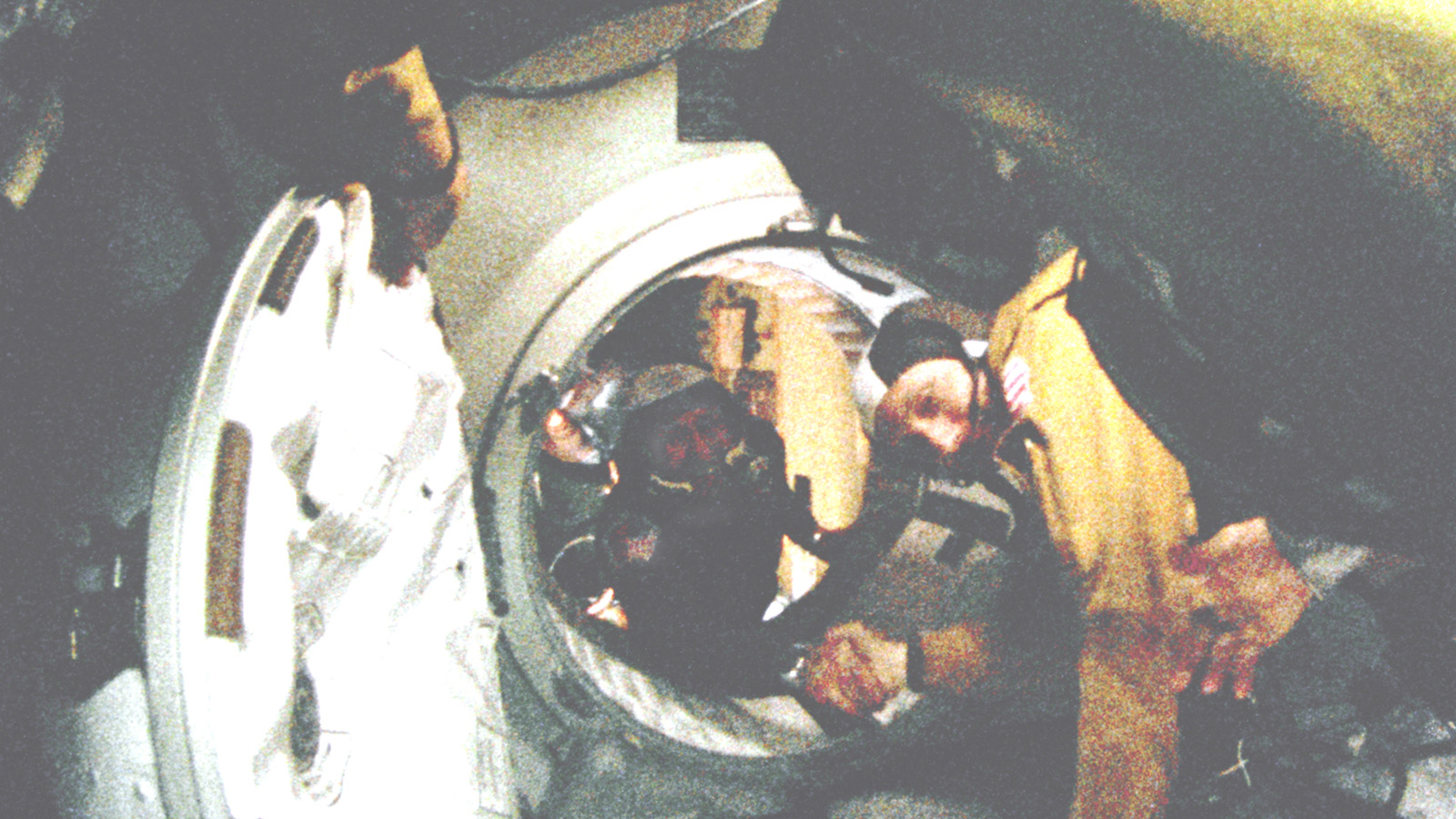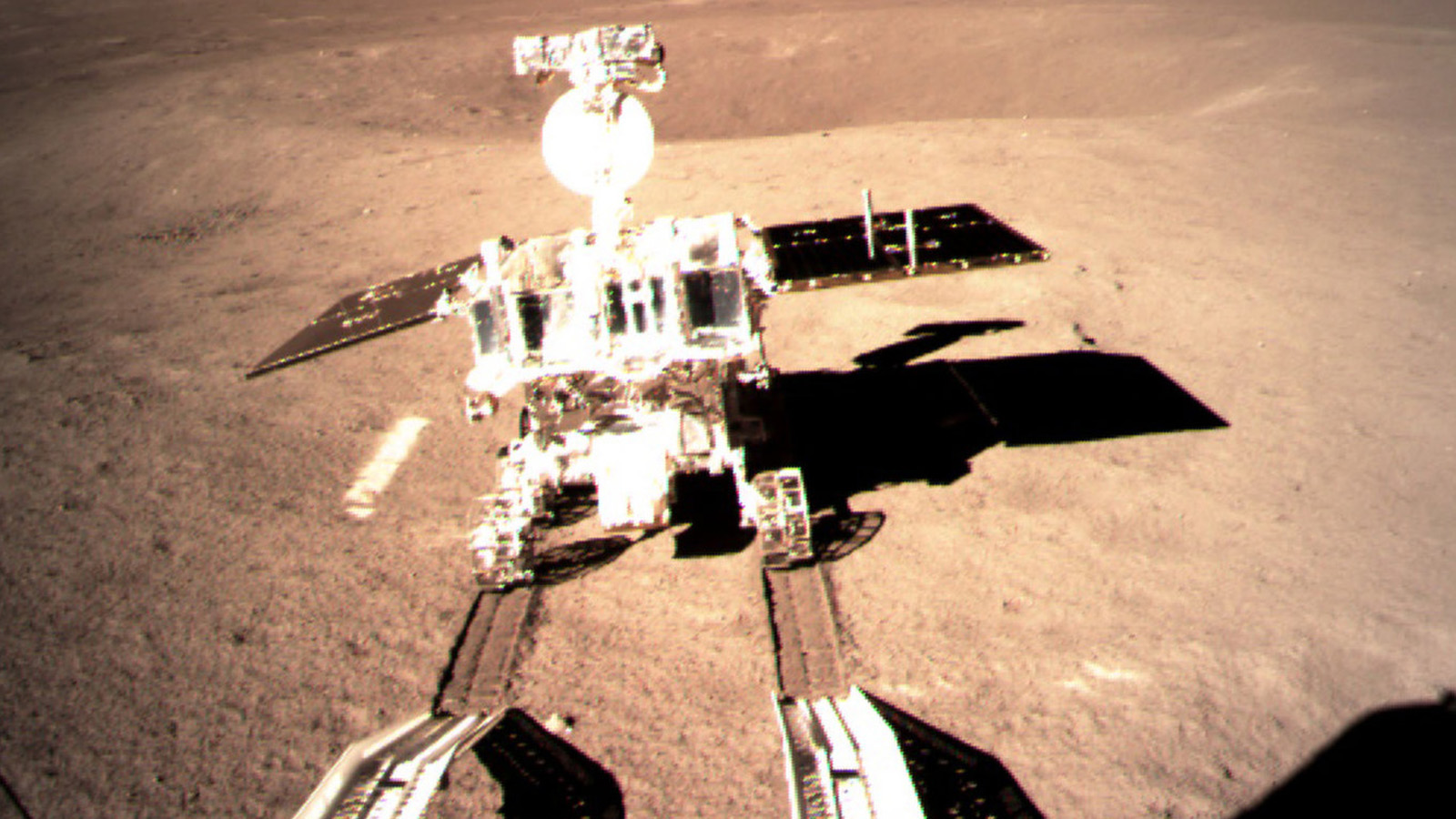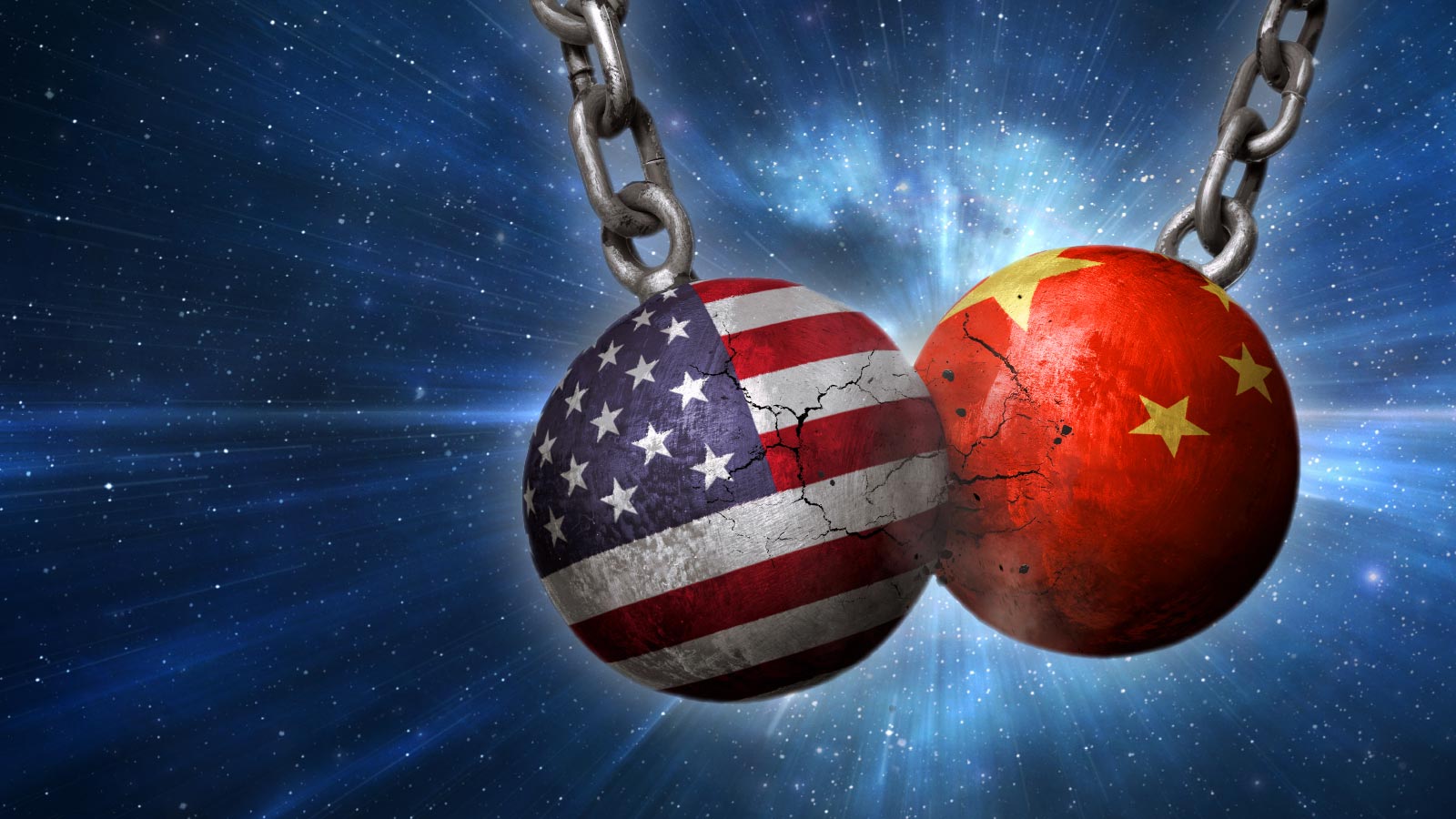Stay Up to Date
Submit your email address to receive the latest industry and Aerospace America news.
China and the United States are on a dangerous collision course as they eye the moon and Mars as repositories of natural resources. Can the peace in space be kept? Sarah Wells went looking for answers.
At just after noon Eastern time in the United States on Thursday, July 17, 1975, a group of five men changed the trajectory of space exploration. Citizens in the Soviet Union and the United States watched grainy, live TV coverage as an Apollo service module and command module moved into a circular orbit around a Soviet Soyuz craft and prepared to dock.
Three hours later, cosmonaut Alexei Leonov, the Soyuz commander, and astronaut Thomas Stafford, the Apollo commander, grasped hands across the transfer corridor linking the two spacecraft.
“Glad to see you. Very, very happy to see you,” Leonov told Stafford in English.
The Apollo-Soyuz “handshake in space,” as history knows it, became the springboard for today’s collaboration aboard the International Space Station. The United States and Russia, the heir to the Soviet space program, have so far kept their Earthly tensions from spreading to space in a significant way, even in the Putin era.
These days, however, Russia is not the nation with the boldest space ambitions compared to those of the United States. Leading the way is China. The China National Space Administration, CNSA, landed its Zhurong robotic rover on Mars in May, after returning lunar soil samples to China from the Chang’e 5 lander in 2020, which followed landing the Yutu-2 rover on the moon in 2018 and the original Yutu in 2013. Closer to Earth, CNSA is assembling its own space station, Tiangong, and since June has had three taikonauts aboard the planned station’s core module Tianhe. A state-owned Chinese rocket manufacturer also announced in June that it plans to undertake its first crewed mission to Mars in 2033.
The situation, arguably, bears some resemblance to the space competition between the Soviet Union and United States in the 1960s and ’70s, although this one involves deep space as well as Earth orbit. Could a handshake moment be coming between American astronauts and Chinese taikonauts? None of the half-dozen space lawyers, analysts, retired generals and historians I spoke to for this article thinks so. They see no evidence that China and the United States are engaged in the kind of diplomatic outreach that preceded the Apollo-Soyuz mission. This lack of diplomacy has some experts calling for establishment of clear rules for all space actors, especially China and the United States. Otherwise, the world risks learning the hard way that these adversaries overestimated their ability to fight safely in space, without endangering the satellites that are vital to civil society and global commerce.
Gauging intent
For its part, China asserts that its intentions in space are peaceful. According to Liu Pengyu, a spokesman for the Chinese Embassy in Washington, D.C., China’s overarching goals are to “improve mankind’s scientific understanding of the universe, expand and extend the space for human activities and advance the sustainable development of human civilization.”
The United States remains more than skeptical. According to the 2021 Annual Threat Assessment report from the U.S. Office of Director of National Intelligence, China is continuing to “field new destructive and nondestructive ground- and space-based antisatellite (ASAT) weapons” that will be “integral to potential military campaigns by the PLA [People’s Liberation Army].” With more government and commercial satellites in orbit than any other nation, the United States affords China with lots of potential targets.
In part as a response to this rising action, the United States created the U.S. Space Force in 2019. Among its activities, the new service is funding the next generation of ground-based satellite jammers, the Counter Communications System Meadowlands. Each Meadowlands system, consisting of signal processors and other equipment, is a non-kinetic weapon and a sleeker successor to the U.S. Air Force’s Counter Communications System that began operations in 2004.
A complicated history
Collaboration in space between China and the United States has been tried before. In the 1990s, the U.S. briefly permitted commercial satellites built in the United States to be launched on Chinese Long March rockets, an experiment that ended in 1999 when a congressional investigation concluded that U.S. contractors illegally transferred rocketry “know-how” to China in hopes of improving the nation’s success rate for launch customers. The relationship soured further a decade ago, when an amendment was introduced in a 2011 Department of Defense appropriations bill that prohibited bilateral cooperation between the U.S. and China in space. Originally proposed by then-Rep. Frank Wolf, who alleged that China hacked his office’s computers in 2006, the “Wolf Amendment’’ has been included and made binding in every defense appropriations bill since 2011, including in 2021.
“It has persisted because a large bipartisan majority on the appropriations subcommittee still support it,” says Gregory Kulacki, manager of the China Project at the Union of Concerned Scientists.
This amendment makes it so that NASA and CNSA cannot work together without a certification from the FBI and congressional approval. This certification includes verifying there’s no risk of sensitive information sharing and that Chinese officials involved have no direct connection to the violation of human rights. The FBI gave that certification when NASA’s Lunar Reconnaissance Orbiter helped track CNSA’s rover Yutu 2 in 2019. While Kulacki says the Wolf Amendment cannot be held directly responsible for China’s absence from the ISS — opposition to it joining and growing disinterest from the Chinese to join predate the introduction of the amendment — it does limit China’s future participation.
“As long as the amendment remains, it is not even possible for NASA to talk to China about the possibility of Chinese participation,” he says.
The amendment also came close to banning U.S.-based Chinese scientists from the Kepler Science Conference II at NASA’s Ames Research Center in 2013 before language was clarified prior to the conference that same year to allow Chinese scientists to participate in such events.
In the view of Kulacki, the Wolf amendment cut off the U.S.-China relationship at the worst possible time.
“There was a window when the Chinese really wanted to cooperate with the United States and meaningful relationships, both institutional and personal, were being built, but that window is closed now,” he says. “The Chinese have no real motivation to put up with the politicizing of space science and exploration that has happened because of these restrictions in the United States.”
The Wolf Amendment and the funding whims of American politicians from one presidential administration to the next make the United States an unappealing collaborator from the perspective of China, he says.
Even if the two nations did want to collaborate, there is disagreement about who should be the first to mend this relationship.
“China seems to be trying to pick fights with the West. And to what goal I don’t understand,” Mike Griffin, who was NASA administrator during the George W. Bush administration and chief technology officer in the Trump Pentagon, told Aerospace America in an interview. He was referring to the islands China has built in the South China Sea to claim sovereignty over the surrounding waters. “Collaboration with China in deep space seems to me to be dependent more upon their behavior than ours.”
China’s view is just the opposite, based on my discussion with Liu at the Chinese Embassy over the possibility of American-Chinese collaboration: “The ball is on the U.S. side,” Liu says.
For China, its antipathy likely dates back to the 1955 U.S. deportation of engineer Xuesen Qian. As experts in space history told the BBC in 2020, Qian came to the U.S. in 1935 to study aero- and astronautical engineering, eventually arriving at Caltech in California. There, he made friends with members of the university’s “Suicide Squad” — so named because the group was attempting to build a rocket on campus.
The squad’s rocket work came to the attention of the U.S. government, which in 1943 provided funding to create the Jet Propulsion Laboratory under the direction of Qian’s academic mentor, Theodore von Kármán. Qian and other Suicide Squad colleagues were given top-level security clearances for the government-funded project.
But then, anti-communist McCarthyism spread across the United States in the 1950s. Both Qian and another member of the Suicide Squad were accused of being members of the Communist Party. After five years of partial house arrest in California, Qian was deported to China with his wife and two American-born children. According to the BBC, after the experience, Qian swore to reporters that he’d “never step foot in America again.”
Qian’s house arrest and deportation were far from the end of his scientific career, however, and in China he is known as the “Father of Chinese Rocketry.”
“The origins of the two space programs are tied up in this one very interesting Chinese individual,” says Kulacki of the Union of Concerned Scientists.
While this icing out of China in the early days of the American space program may have slowed China’s progress initially, Kulacki says the lasting impact was to make China’s National Space Administration more self-reliant. While China does have a history of collaborating with other international space programs, including the European Space Agency, it might be too late to change courses with NASA.
“I think China’s relatively independent now and really doesn’t need the United States at all to continue making substantial progress in space,” Kulacki says.
Though lauded for its exploration achievements, China has also faced international criticism for its go-it-alone approach in other areas, such as when debris from a Chinese rocket reportedly fell into the Indian Ocean in May. While there was no damage, NASA Administrator Bill Nelson said in a press statement at the time that China was “failing to meet responsible standards regarding their space debris.”
Modern day
China’s military space program might also be larger than it seems. CNSA, an ostensibly civilian agency, has gained a foothold in space exploration and technology, but its stature in China is sometimes misunderstood in the West, said Dean Cheng, a senior research fellow at the Heritage Foundation focusing on Asian studies and foreign policy.
“It is very, very low down on the bureaucratic totem pole and really doesn’t have anywhere near the authority of NASA,” Cheng says.
NASA’s work is largely distinct from the Pentagon, but the Chinese military has tight control over how things are done at CNSA, including where, when and how rockets are launched, says Cheng.
“Everyone who is part of that staff, whether they are in uniform or not, are in the military,” says Cheng, referring to CNSA’s launch bases.
Beyond CNSA, Cheng says it’s really the People’s Liberation Army Strategic Support Force that has military control over space efforts as well as electronic and cyberwarfare. In this way, the PLA’s Strategic Support Force includes elements that are the functional equivalents of those of the U.S. Space Force, National Security Agency and Space Command, he says.
Another difference between CNSA and NASA, says Cheng, is CNSA’s relative lack of transparency when it comes to sharing both funding and data.
“We do not have a figure on China’s space budget, not even broad outlines,” says Cheng. “We simply don’t.” He says the program is even “more opaque” than that of the Soviet Union before its dissolution.
As for CNSA’s data sharing, it has historically been slower than that of NASA, which has an open access model for sharing its planetary and cosmic data (such as the chemical composition of Martian soil) with the international scientific community. Similar data from CNSA’s Zhurong rover has been slow to reach research scientists beyond China, says Jim Bell, an Arizona State professor of planetary science and principal investigator for the Mastcam-Z imaging system on NASA’s Perseverance Mars rover.
For Cheng, the slow sharing of scientific data does not amount to a national security concern, but the technology that enables these missions could be a potential threat.
“Going to Mars in and of itself doesn’t really create a threat,” says Cheng. “The issue is that in order to get to Mars you need deep space tracking capabilities and you’ll also want a network of Earth-based observation posts so that you can track your Martian probes.”
And if you can track your own probes using this technology, there’s no reason you couldn’t track other spacecraft as well, including U.S. satellites in geostationary and low-Earth orbit, Cheng says.
A new road map
Simply put, there aren’t going to be rover wars on Mars, or even the moon, predicts Cheng. These scientific experiments are too expensive and too far away to be dragged into such a fight. But perhaps the same can’t be said for objects in low-Earth orbit, such as satellites, or even potentially resources on the lunar surface, says retired U.S. Air Force Gen. Robert Kehler. During his military career, Kehler commanded Air Force Space Command and later U.S. Strategic Command.
“The United States has said clearly that we believe that there is a high likelihood that a future conflict will either begin or quickly extend into space,” says Kehler. That view raises space to the same level as air or sea as a possible war-fighting domain. Such fights may encompass technology that jams or dazzles satellites or anti-satellite weapons that would even shoot satellites out of orbit.
This evolving swath of space activities is made only more complicated by the introduction of commercial space companies into the mix, says Kehler. For example, if an India-funded lunar mining company from the UAE happens to break a U.S. law, who is at fault and what would be the redress? The United Nations attempted to lay the groundwork for answering future questions like these in 1967 when it adopted the Outer Space Treaty. Among other principles, the treaty states that “outer space is not subject to national appropriation by claim of sovereignty.” This treaty, however, did not anticipate the rise of commercial space companies looking to exploit space independently of national governments.
In an attempt to build on this treaty, the U.S. in 2020 laid out a separate common set of standards for how nations — and their commercial companies — should conduct their research on the lunar surface called the Artemis Accords. The accords seek to protect “historically significant human or robotic landing sites,” like China’s rovers or the U.S. American flag. It also lays out guidelines for resource extraction, including that they should be “safe and sustainable.” Other language details how nations should interact: “the Signatories commit to seek to refrain from any intentional actions that may create harmful interference with each other’s use of outer space in their activities under these Accords.” While 12 countries including the United Arab Emirates, Japan and the United Kingdom have signed these accords, China and Russia have not.
In the view of Kehler, the Artemis Accords and Outer Space Treaty are simply not strong or specific enough. “I think it’s time for the international community to get very serious about what’s called the ‘rules of the road,’” he says. “The current regulatory structure is grossly inadequate [for] what’s really happening and what’s about to happen,” he says, referring to the tremendous growth of commercial space exploration on the horizon.
One promising path forward, says Joanne Gabrynowicz, a professor of space law at the University of Mississippi and editor-in-chief emerita of the Journal of Space Law, would be to treat space and celestial surfaces — whether they be planets, moons or comets — as a global commons, similar to international waters. This is something already being discussed at the U.N. by the U.S. and Luxembourg, which has plans to become Europe’s space mining hub.
“Luxembourg and the U.S. both accept the high-seas analogy when it comes to space resource extraction,” says Gabrynowicz. “The Pacific Ocean can’t be claimed by any one nation, but fish can be extracted from it.
“The question arises about what can be done with the extracted resource,” continues Gabrynowicz. “The U.S. view is that like the fish, once a space resource is extracted it can become property. The Luxembourg view is that an international multilateral framework must be developed to address the status of extracted space resources.”
So is a handshake the answer? Cheng has a firm opinion about this.
“Could the U.S. and China cooperate?” he asks. “Yes, we could certainly have a one-off. But if you think that’s going to somehow either change U.S.-China relations or lead to deeper space cooperation, you’re going to have a skeptic on your hands.”
Ultimately, it will always be political partnerships and discussions on Earth that impact behavior in space, and not the other way round, he says, even as beautiful as the Apollo-Soyuz handshake might have looked from the outside.
About Sarah Wells
Sarah is a science and technology journalist based in Boston interested in how innovation and research intersect with our daily lives. She has written for a number of national publications and covers innovation news at Inverse.
Related Posts
Stay Up to Date
Submit your email address to receive the latest industry and Aerospace America news.







